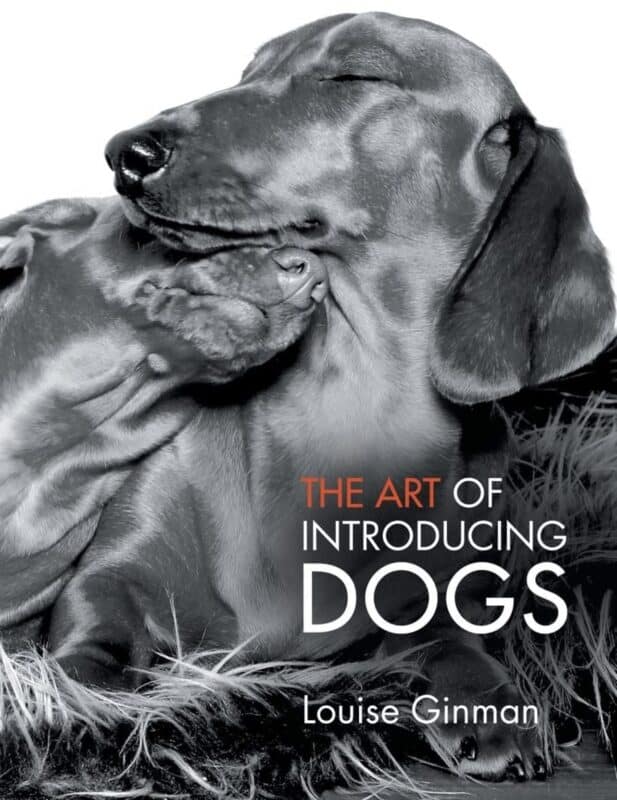Dog to Dog Introductions, Introducing Dogs, The Art of Introducing Dogs
The Art of Introducing Dogs
The Art of Introducing Dogs an Overview of Louise Ginman’s Book by Will Bangura, M.S., CBCC-KA, CPDT-KA, (Dog Behaviorist,) Certified Behavior Consultant.
Introducing dogs can be a complex and crucial process that requires careful planning and execution, particularly when dealing with aggressive or fearful dogs. Inadequate introductions can lead to serious injuries and even fatalities for both the dogs involved and their pet guardians or handlers. Therefore, it is essential to follow a comprehensive protocol that considers the individual characteristics and needs of the dogs, as well as the environmental and situational factors that can influence their behavior.
This article will provide a detailed and evidence-based approach to safely introducing dogs, based on the principles outlined in Louise Ginman’s book “The Art of Introducing Dogs.” We will explore the importance of proper socialization and training for dogs and the role of human behavior in shaping their interactions with other dogs. We will also review the different methods and techniques that can be used to introduce dogs, highlighting their benefits and limitations. Finally, we will discuss the potential risks and challenges associated with introducing dogs and offer tips and strategies to mitigate them. By following this protocol and incorporating the latest research and best practices in dog behavior and training, dog pet guardians and trainers can enhance the socialization and well-being of their dogs while minimizing the risk of aggression and other behavioral problems.
Pre-Introduction Preparation.
Before introducing dogs, taking several steps to prepare for a safe and successful interaction is crucial. One of the most critical steps is to assess each dog’s behavior, temperament, and physical health. Dogs should be up to date on vaccinations and have no underlying health conditions that could affect their behavior during the introduction. It is also important to ensure that the dogs are physically fit and able to interact without causing harm to themselves or others.
Pet guardians should also evaluate the dogs’ personalities and behavioral tendencies to determine the best approach for the introduction. It is important to consider each dog’s age, breed, size, previous socialization experiences, and any known behavioral issues or tendencies. For example, if one dog is aggressive, the introduction process may need to be more gradual and involve more management and training. Similarly, if one dog is fearful or anxious, the introduction may need to be slower and more structured to avoid triggering negative behaviors.
Another important aspect of pre-introduction preparation is scent exchange. Before the introduction, the dogs should be introduced to each other’s scent by exchanging items such as blankets or toys each dog uses. This helps familiarize the dogs with each other’s scent and can reduce the likelihood of aggression during the introduction. This process is called “scent swapping,” It allows the dogs to become familiar with each other’s scent before meeting face-to-face.
In addition to scent exchange, preparing the environment for the introduction is important. The introduction should take place in a neutral location, away from the dogs’ home territory, to reduce the likelihood of territorial behavior. The area should be free of distractions and stimuli that could cause anxiety or arousal in the dogs, such as loud noises or unfamiliar smells. The environment should also be large enough to allow the dogs to move freely but not so large that they are out of the pet guardian’s control.
Lastly, pet guardians should be prepared to manage the dogs’ behavior during the introduction. This may involve using leashes, muzzles, or other safety equipment to prevent aggressive or harmful behavior. Pet guardians should also be prepared to intervene and separate the dogs, using a loud and firm voice to distract and redirect their attention. It is important to remain calm and in control throughout the introduction, as the dogs will pick up on the pet guardian’s emotions and behavior.
Overall, pre-introduction preparation is critical to ensuring a safe and successful introduction. By assessing each dog’s behavior and personality, exchanging scents, preparing the environment, and being prepared to manage the dogs’ behavior, pet guardians can reduce the risk of aggression and increase the likelihood of a positive and enjoyable interaction between the dogs.
Introduction.
The introduction process is critical to safely introducing dogs to each other. It is important to remember that dogs are social animals with individual personalities and temperaments that can impact their behavior during introductions. In addition to selecting a neutral location, several steps should be taken to ensure a safe and successful introduction.
Firstly, it is essential to have both dogs on a leash and under the control of their pet guardians. This helps to prevent any unexpected interactions between the dogs and allows their pet guardians to monitor their behavior closely. Additionally, the pet guardians should remain calm and relaxed throughout the introduction, as dogs can sense their pet guardians’ anxiety or tension.
During the initial introduction, the dogs should be kept at a safe distance from each other. The distance between the dogs should gradually decrease as long as both dogs remain calm and relaxed. However, if either dog becomes agitated or aggressive, the distance between the dogs should be increased until both dogs are calm again.
The dogs’ body language should be carefully monitored during the introduction process. Subtle cues such as raised fur, growling, or baring teeth could indicate aggression or discomfort. The dogs should be separated immediately if any signs of aggression or discomfort arise.
Once the initial introduction has been completed, the dogs should be separated and allowed to rest briefly. If the introduction is successful, the dogs can be reintroduced, this time in a more controlled setting such as a fenced-in yard. It is essential to continue monitoring the dogs’ behavior during subsequent introductions and to remain patient throughout the process.
The introduction process should be carefully planned and executed to ensure a safe and successful introduction between dogs. It is essential to have both dogs on a leash, select a neutral location, monitor their behavior closely, and remain patient throughout the process.
Ongoing Management.
Ongoing management is critical to safely introducing and maintaining a positive relationship between dogs. Even after a successful introduction, it is important to continue monitoring the dogs’ interactions and body language during subsequent meetings.
One of the most effective ways to manage the dogs is to separate them if any signs of aggression or discomfort arise. This can include separating them in different rooms or using a barrier to separate them in the same room. If any aggressive or uncomfortable behavior persists, it may be necessary to seek the assistance of a professional dog trainer or behaviorist.
Pet guardians should also reward positive behavior between the dogs for reinforcing a positive relationship. This can include verbal praise, treats, or toys. It is important to note that punishment or negative reinforcement should not be used as it can cause fear, anxiety, and aggression among the dogs.
In addition to managing the dogs’ behavior during interactions, pet guardians should continue to acclimate the dogs to each other’s scent. This can be done by exchanging items such as blankets, toys, or bedding each dog uses. Additionally, allowing the dogs to spend time in each other’s space can help to establish a positive association between the dogs.
Remembering that ongoing management and training are necessary to maintain a positive relationship between dogs is important. Pet guardians should remain vigilant and patient throughout the process and seek professional assistance if necessary. Following these steps, pet guardians can help ensure a safe and positive relationship between their dogs.
Introducing dogs requires careful consideration, planning, and management. It is essential to assess each dog’s behavior and temperament and prepare them for the introduction by familiarizing them with each other’s scent. The introduction should take place in a neutral location with both dogs under control, and their body language should be monitored closely for any signs of aggression or discomfort. Ongoing management and training are also necessary to maintain a positive relationship between the dogs. Following the protocol outlined in “The Art of Introducing Dogs” by Louise Ginman, pet guardians can successfully introduce their dogs and establish a harmonious relationship. Remember that dogs are different; some may require more time and training than others. Still, a safe and successful introduction is possible with patience and persistence.
References.
- Ginman, L. (2018). The art of introducing dogs. Dogwise Publishing.
- American Veterinary Society of Animal Behavior. (2008). AVSAB position statement on puppy socialization. Journal of the American Veterinary Medical Association, 233(6), 819-822.
- Arhant, C., Bubna-Littitz, H., Bartels, A., Futschik, A., & Troxler, J. (2010). Behaviour of smaller and larger dogs: effects of training methods, inconsistency of owner behaviour and level of engagement in activities with the dog. Applied Animal Behaviour Science, 123(3-4), 131-142.
- Cottam, N., & Dodman, N. H. (2018). A systematic review of the scientific evidence addressing the effects of breed, breed labeling, and bias on dog bite-related fatalities. Journal of the American Veterinary Medical Association, 253(3), 281-292
- Cusack, L., & Williams, J. M. (2019). The effect of different levels of human socialization on the behaviour of domestic dogs (Canis lupus familiaris) in a shelter setting. Applied Animal Behaviour Science, 210, 45-51.
- Ekarius, C. (2017). Dog behavior for dummies. John Wiley & Sons.
- Overall, K. L. (2013). Manual of clinical behavioral medicine for dogs and cats. Elsevier Health Sciences.
- Serpell, J. A., & Jagoe, J. A. (1995). Early experience and the development of behavior. In The domestic dog: Its evolution, behaviour and interactions with people (pp. 79-102). Cambridge University Press.
- Smith, B. P., & Litchfield, C. A. (2013). A systematic review of personality test instruments used in research on welfare outcomes for domestic dogs. Animal Welfare, 22(4), 431-438.


